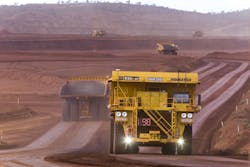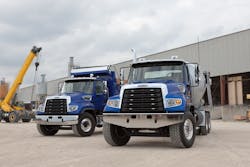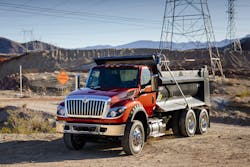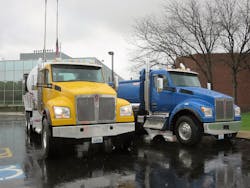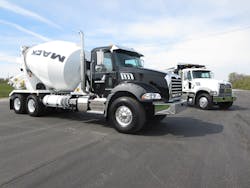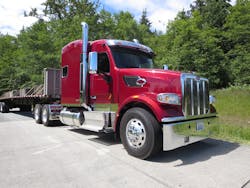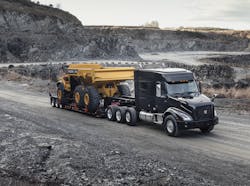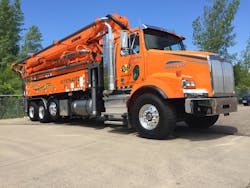Autonomous Trucks Still Down the Road
Ned Ludd never drove a truck. They didn’t exist in 1779 when, folklore says, he smashed a weaving machine in a “fit of passion.” This the young Englishman did after being beaten by his boss for idleness, or simply being told by his father, also a weaver, to “square his needles”—the accounts of the long-ago event vary. Indeed, Ludd the man may never have existed, but in the next century, textile workers who protested the introduction of job-killing machinery, sabotaging a lot of it, did so in his name. These angry people came to be called Luddites, and the term today describes folks opposed to technological progress, especially the type that threatens human employment and dignity.
Thousands of factory workers have been displaced by modern robotic machines that weld, assemble, and paint parts for all kinds of products. Often the robots do repetitive, intricate, hot, and sometimes dangerous tasks that are difficult for humans. After final assembly, products go out in trucks that connect those factories with each other, and take the items to markets where they are sold. Driving regionally and over the road can be lonely and mind-numbing, but it employs almost 2 million people, according to the federal Bureau of Labor Statistics. Eventually those jobs could be at risk, because autonomous technology now being developed aims at on-highway drivers.
That load of Coors beer autonomously hauled down Interstate 25 in Colorado last year garnered much publicity. News stories noted the presence of a driver in the cab, and video showed him stepping into the sleeper while the semi was underway. The implication: He could have stayed at home. But some argue that even in advanced operations, a driver would still be needed to monitor the automated truck and, at each end of the haul, to guide the rig to where it needs to go. Others say no, because yards and terminals will also be automated.
Robotic trucks could help solve the long-haul truck driver shortage that, except for recessions, has existed for scores of years, as well as turnover that in some companies exceeds 90 percent a year. The current shortage is estimated at 50,000 and will worseen as older drivers retire and young people can’t be found to replace them. But if enough over-the-road freighters could be run without drivers—singly or in twos and threes in a process called platooning—that might more than solve the shortage. Will laid-off truckers become modern-day Luddites?
Autonomous mining trucks
In Western Australia, giant haul trucks have been operating autonomously in Rio Tinto’s Mine of the Future project, begun 10 years ago. Komatsu equipment (above) uses GPS signals to guide the iron ore-toting trucks along trails as humans in Perth, hundreds of miles away, watch over them. Robotic controls enhance safety because they work hour after hour without falling asleep, and trucks run on 13 percent less fuel. Drilling and loading machines have also been automated, the company says, and locomotives on its private railway soon will be. Automation eliminates jobs, but Rio Tinto says it has been difficult to attract young people to work in the bleak Australian Outback anyway.
In the same region, Caterpillar has applied its Cat Command automation system to a group of driverless Cat 793F haul trucks for Fortesque Metals Group at its Solomon Mine. Day and night, the trucks continuously move iron ore, stopping precisely for loading and unloading. When directed, they come in for fueling and maintenance. Cat says it can apply its Command systems to other makes of haul trucks, too.
For freight carriage, Daimler, Paccar, Volvo, and other truck and component manufacturers are working on their own autonomous truck projects. In Germany, ZF Friedrichshafen has an Innovation Truck that will maneuver around a terminal with no one behind the wheel. In the U.S., Daimler has set up a center for autonomous development in Oregon. In Michigan, Eaton is working on a program that will enable a properly equipped tractor to back a trailer into a loading dock.
When with autonomous hit construction?
The leap onto on/off-road construction trucks, which run on busy city streets and suburban roads, and then onto job sites, will not come soon. That would be much more difficult technically and financially, according to Jason Roycht, vice president for regional business, commercial vehicle and off-road, at Robert Bosch.
“Radar, vision, and ultrasonic actions don’t function as well in an off-road environment as on-road,” Roycht says. “Construction sites don’t have level ground, and they have piles of dirt and materials that are there one moment and gone the next moment. Also, construction sites have a lot of people walking around, and they don’t have designated safety areas.”
Most American Class 8 truck manufacturers now design, build, and sell their own diesels. Read "The State of Proprietary Diesels."
Richard Bishop, a consultant in autonomous vehicle development for on-highway use, thinks large work sites could be automated. “If you have a multiyear construction site, you could treat that with a geofence” that, using GPS locating, keeps operations within a specified area, “and you could operate it as a robo taxi,” like Uber, the ride-sharing company, is working on.
“You might want to retrofit existing trucks,” he says. “In a completely automated construction site, if you make sure all vehicles are automated, they could operate together, maybe more closely together. So if a truck comes in from the street with materials, he’d have to integrate into that operation.”
Dump trucks, concrete mixers, and other trucks spend more time running on streets and freeways than on job sites. Yet unlike “orderly” rural Interstate highways, urban streets are a jumble of vehicular traffic that’s moving, stopped, and parked, plus pedestrians, bicyclists, and other distractions to a truck’s sensing systems, Roycht says.
Still, an Uber system for city operation could presumably be applied to construction trucks. They then could be programmed to run from loading points to job sites for materials deliveries. Artificial intelligence would allow them to cope with congestion and interruptions. That would work for big projects where loads would be repeatedly hauled along a set route, but unless the destination site is automated, someone would have to jump into the cab to pilot a truck to exactly where materials would be needed. The labor savings are questionable. Autonomous trucks would have more difficulty taking different loads to different customers each day, especially when they would have to maneuver into a unique place to dump or place the materials.
Expense is the other roadblock to autonomy for construction trucks, Roycht says. A robotic truck’s radar, cameras, sensors, and computer software, not to mention computers and electronically controlled components, are expensive to begin with. Moreover, the tough environment in which such trucks work would require robust dirt- and water-resistant devices and shock-resistant mounting. All that might cost $10,000 to $15,000 per truck. If not employed many hours every day, they couldn’t pay for themselves in a reasonable amount of time.
Gallery of Heavy Trucks
All this conspires to keep automated driving for construction trucks in the somewhat distant future. Peter Vaughn Schmidt, who heads autonomous development at Daimler Trucks North America, offered a summary:
“We will apply our learnings and developments to business cases that make sense for our customers,” he says. “We are exploring automated technology for commercial vehicles and foresee highly automated driving pilots first in interstate and hub-to-hub applications. Our second priority is highly automated pilots in gated areas. Construction is not a priority for the first pilot applications, but will be a fast follower to airfields, agriculture, and logistic hubs.”
Fleet managers cannot remotely control their trucks, but thanks to telematics, they can remotely see what their drivers are doing with them. And with data sent via cell phone connections, they can know when service is due and a component is failing, all while the truck is on the road or job site. When detecting a problem, some systems alert not only the driver and manager, but also the closest dealer’s service department; determine if necessary parts and tools are in stock and if not, order them; and schedule an appointment.
On-board diagnostics help a technician with finding and repairing the problem. Some systems can update the software in a truck’s on-board computers “over the air,” so the truck doesn’t have to go in for that service. Telematics are standard on many truck models, and it’s up to fleet managers to use them. An increasing number are, the builders say.
Self-shifting transmissions
One form of automation has been with us since the late 1940s: automatic transmissions, first in cars and light trucks, and later in medium- and heavy-duty commercial trucks. Today, truck builders report that a large majority of highway and vocational trucks are equipped with automatic and automated-manual transmissions. At Volvo, for instance, nine out of 10 highway trucks go out the factory door with I-Shift automated transmissions, as do “most” vocational trucks, a spokesperson says. The numbers are similar at Volvo’s sister company, Mack, where Granites are increasingly equipped with mDrive automateds and Allison torque-converter automatics, and at competitors, who use Allisons and vocational versions of Eaton UltraShift Plus automateds.
Compared to manual gearboxes, self-shifting transmissions offer greater fuel efficiency, reduce shock to drivelines, and greatly cut workload so drivers can concentrate on traffic and maneuvering their trucks. That improves safety. There’s also a practical reason: Many younger drivers simply can’t handle manuals.
“More than 90 percent of the vocational trucks we sell have automatic transmissions,” says Jonah Schneider, a sales representative at Fyda Freightliner in Columbus, Ohio. “Young people today have never driven manual transmissions. They grew up with automatics. So fleets can’t get drivers for their trucks.” Allison automatics and Eaton automated gearboxes solve that problem, and more than pay back their extra cost.
